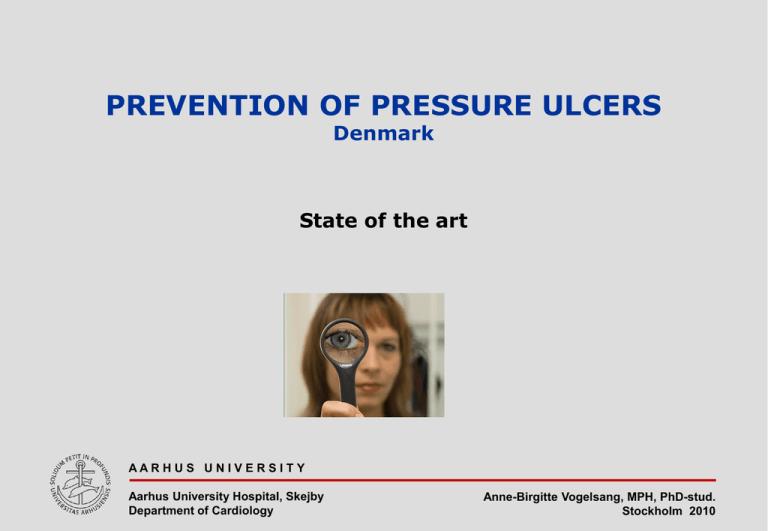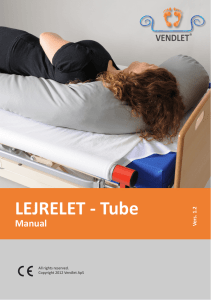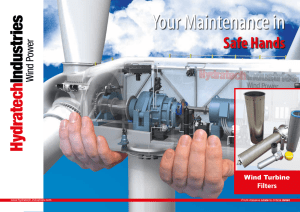State of the art
advertisement

PREVENTION OF PRESSURE ULCERS Denmark State of the art AAR H U S U N I V E R S I T Y Aarhus University Hospital, Skejby Department of Cardiology Anne-Birgitte Vogelsang, MPH, PhD-stud. Stockholm 2010 Background Pressure ulcer Are caused by Localised pressure -> Deformation of skin and soft tissues -> Distorting cells, reducing blood flow -> Inducing ischemia and necrosis. Takahashi M, Wounds International, 2010 AAR H U S U N I V E R S I T E T Aarhus University Hospital, Skejby Department of Cardiology Anne-Birgitte Vogelsang, MPH, PhD-stud. Stockholm 2010 Background what is going on? Tissue distortion due to pressure Roaf R, J Tissue Viability 2006 AAR H U S U N I V E R S I T E T Aarhus University Hospital, Skejby Department of Cardiology Anne-Birgitte Vogelsang, MPH, PhD-stud. Stockholm 2010 Background what is going on? Pressure and duration that are likely to result in tissue damage. Takahashi M, Wounds International, 2010 AAR H U S U N I V E R S I T E T Aarhus University Hospital, Skejby Department of Cardiology Anne-Birgitte Vogelsang, MPH, PhD-stud. Stockholm 2010 Background Are pressure ulcers still a challenge in Danish Hospitals? Six resent Danish cross sectional, in hospital, studies have shown a pressure ulcer prevalence of 14 – 66% More than 5% of these were category 3 – 4 ulcers. Nationwide this correspond to the use of ap. 1.500 manyears on treating pressure ulcers. Bermark, S, vol2: 2010 EWMA J Dumiel-Peeters I, 2006; J Clin Nurse AAR H U S U N I V E R S I T E T Aarhus University Hospital, Skejby Department of Cardiology Anne-Birgitte Vogelsang, MPH, PhD-stud. Stockholm 2010 Challenges Identifying persons at risk How, when, how often? How to monitor the frequency of pressure sores? Prevalence / incidence? Effective evidence-based prevention strategy? Clinical guidelines? Generic or disease specific Implementation of strategies How AAR H U S U N I V E R S I T E T Aarhus University Hospital, Skejby Department of Cardiology Anne-Birgitte Vogelsang, MPH, PhD-stud. Stockholm 2010 Challenges Adoption of the strategies (guidelines) Who is responsible? Education and equipment? How to maintain? Documentation of risk and preventive actions How? When? What is sufficient? AAR H U S U N I V E R S I T E T Aarhus University Hospital, Skejby Department of Cardiology Anne-Birgitte Vogelsang, MPH, PhD-stud. Stockholm 2010 State of the art Risk assessment = Identifying persons at risk Many different risk assessment instruments have been develop and used during the past 20 years Their ability to indentify persons at risk of having pressure ulcers have though not been convincing AAR H U S U N I V E R S I T E T Aarhus University Hospital, Skejby Department of Cardiology Pancorbo-Hidalgo PL et al. Journal of Advanced Nursing 2006; 54(1):94-110. Schoonhoven L et al . Medical Journal 2002; 325(7368):797-800. Seongsook RNJ et all. Journal of Nursing Studies 2004; 41(2):199-204. Defloor T, Grypdonck MF. Journal of Clinical Nursing 2005; 14(3):373-382. Anne-Birgitte Vogelsang, MPH, PhD-stud. Stockholm 2010 State of the art Risk assessment = identifying persons at risk Vogelsang AB, 2004, research Purpose To conduct a valid prognostic index/risk assessment instrument (Adhoc) To evaluate the prediction validity of Adhoc versus the Braden assessment scale Vogelsang AB, Bladet SÅR, 2004 AAR H U S U N I V E R S I T E T Aarhus University Hospital Department of Cardiology Anne-Birgitte Vogelsang, MPH, PhD-stud. Stockholm 2010 State of the art: Risk assessment Adhoc Considered at risk are only persons who are not selfreliant Exception: Persons with diabetes Score and risk category 0 point 1 - 4 points 5 - 8 points 10 - 11 points No risk Low risk Moderate risk High risk AAR H U S U N I V E R S I T E T Aarhus University Hospital, Skejby Department of Cardiology Anne-Birgitte Vogelsang, MPH, PhD-stud. Stockholm 2010 State of the art: Risk assessment Adhoc State the degree of limitation in activity performance 0 1 2 3 4 NONE or negligible limitation SLIGHTLY limited MODERATE limited STRONGLY limited Activity CAN NOT be performed ( 0– 4%) ( 5 – 14%) (15 – 49%) (50 – 94%) (95 – 100%) Do the person have both the ability and consent to mobility? 0 1 2 Yes Yes, partly No AAR H U S U N I V E R S I T E T Aarhus University Hospital Department of Cardiology Anne-Birgitte Vogelsang, MPH, PhD-stud. Stockholm 2010 State of the art: Risk assessment Adhoc Is friction reducing material used when moving or repositioning the person? 0 1 2 Yes Yes, in average every second time No Has the person been exposed to pressure at the same part of the body for more than 1½ running hour during the past 24 hours? 0 1 2 3 No Yes, once Yes, twice Yes, more than twice AAR H U S U N I V E R S I T E T Aarhus University Hospital Department of Cardiology Anne-Birgitte Vogelsang, MPH, PhD-stud. Stockholm 2010 State of the art: Risk assessment Prediction Risk at 1. registration compared to number of pressure ulcers at the 2. registration AAR H U S U N I V E R S I T E T Aarhus University Hospital Department of Cardiology Anne-Birgitte Vogelsang, MPH, PhD-stud. Stockholm 2010 State of the art: Risk assessment Prediction Braden vs. Adhoc Predicted presence of pressure ulcers correctly Predicted absence of pressure ulcer correctly AAR H U S U N I V E R S I T E T Aarhus University Hospital, Skejby Department of Cardiology Anne-Birgitte Vogelsang, MPH, PhD-stud. Stockholm 2010 State of the art: Risk assessment Conclusion If the high predictive validity for Adhoc could be repeated in a new and independent population, Adhoc could be considered a valid instrument to identify patients at risk of developing pressure ulcer The result from this and other studies leads to the conclusion that although the Braden scale predicts the occurrence of pressure ulcers to some extent, routine use of this scale has to be called into question AAR H U S U N I V E R S I T E T Aarhus University Hospital, Skejby Department of Cardiology Anne-Birgitte Vogelsang, MPH, PhD-stud. Stockholm 2010 State of the art: Monitoring frequency Up until now All Danish studies but one are prevalence studies • We then do not know where and when the ulcers were produced! • Do we really measure quality? AAR H U S U N I V E R S I T E T Aarhus University Hospital, Skejby Department of Cardiology Anne-Birgitte Vogelsang, MPH, PhD-stud. Stockholm 2010 State of the art: Implementation of strategies on equipment Mattresses Around 50% are placed on adequately pressure relieving mattresses No one knows when the patient actually was located on the mattress. Cushions In average 30% of the patients are placed on adequately relieving cushions Heal One hospital did practice this procedure, the rest did not. Bermark, S, 2010 EWMA J AAR H U S U N I V E R S I T E T Aarhus University Hospital, Skejby Department of Cardiology Buttery J, 2010: EWMA J Anne-Birgitte Vogelsang, MPH, PhD-stud. Stockholm 2010 Conclusion: Implementation of strategies on equipment Use of preventive equipment are insufficient and may be introduced too late or perhaps not until the pressure ulcer is visible on the skin Conversely, the use is not reduced as the need for preventive action decreases Even the most simple recommendations are inadequately followed. AAR H U S U N I V E R S I T E T Aarhus University Hospital, Skejby Department of Cardiology Anne-Birgitte Vogelsang, MPH, PhD-stud. Stockholm 2010 State of the art: Documentation of risk and actions Preventive efforts We do not know the degree of documentation, but the percentage is low Categorising pressure ulcers Less than 50% are registered in the nursing journal Treatment plan??? Bermark, S 2010 EWMA J AAR H U S U N I V E R S I T E T Aarhus University Hospital, Skejby Department of Cardiology Buttery J, 2010: EWMA J Anne-Birgitte Vogelsang, MPH, PhD-stud. Stockholm 2010 Conclusion: Documentation of risk and actions Conclusion Planned preventive actions is rarely documented and evaluated. This all most certainly leads to staff spending to much time on the same process. No one really knows if the most simple general recommendations are follow The preventive effort is for certain not individualize corresponding the individual patient risk. AAR H U S U N I V E R S I T E T Aarhus University Hospital, Skejby Department of Cardiology Anne-Birgitte Vogelsang, MPH, PhD-stud. Stockholm 2010 Future recommendations: Prevention of pressure ulcers National guidelines should be defined and cleared Local instructions should be available on the intranet and signed by the department leaders Learning programs should be defined and available on the intranet AAR H U S U N I V E R S I T E T Aarhus University Hospital, Skejby Department of Cardiology Anne-Birgitte Vogelsang, MPH, PhD-stud. Stockholm 2010 Future recommendations: Prevention of pressure ulcers Support/education should be well organized National indicators should be defined Audit should be made on: Pressure ulcer Incidence and Category Percentage of E-learning passed Percentage of patients placed on the right equipment at the right time. AAR H U S U N I V E R S I T E T Aarhus University Hospital, Skejby Department of Cardiology Anne-Birgitte Vogelsang, MPH, PhD-stud. Stockholm 2010 Future ”Forebyggelse af liggesår vha. standardiseret screeningsmetode og sensorlagner” To ensure that appropriate preventive actions are documented and provided to the right patient in time The effect of a simple implementation strategy will be tested in a new Danish project. The interventions are based on a Danish clinical guideline for prevention of pressure ulcer including “Adhoc”. (Aarhus Universitetshospital Skeby, EWMA, OHMATEX) Projektleder Anne-Birgitte Vogelsang AAR H U S U N I V E R S I T E T Aarhus University Hospital, Skejby Department of Cardiology Anne-Birgitte Vogelsang, MPH, PhD-stud. Stockholm 2010 Screening og indsats ”Forebyggelse af liggesår vha screeningsmetode og sensorlagner” SCREENING FOR Risiko Er personen oppegående og selvhjulpen? 1 0 Ja 1 Nej (Hvis nej eller diabetes, udfyld da resten af skemaet) Selvhjulpen og oppegående JA Angiv dato NEJ 2 3 Ikke yderligere tiltag Angiv initialer Screening for trykskade risiko og trykskader Diabetes patienter skal Foretages ved hjælp af screeningsinstrumentet ”Adhoc” . screenes. Vanskelighed ved aktivitet generelt Klokkeslæt SCORE Vilje og evne til bevægelse Anvendelse af friktionsnedsættende hjælpemidler Eksternt tryk mere end 1½ samme sted på kroppen Trykskader og grad 1. Angiv graden af vanskeligheder ved udførelsen af aktivitet generelt. INGEN eller ubetydelige aktivitetsbegrænsninger 0 – 4% LETTE eller nogle aktivitetsbegrænsninger 5 – 14% MODERATE aktivitetsbegrænsninger 15 – 49% SVÆRE aktivitetsbegrænsninger 50 – 94% Aktivitet kan IKKE UDFØRES 95 – 100% 0 1 2 3 4 4 Verifikation af risiko for trykskade Risikoscore 1 - 4 point = Risikoscore 5 - 8 point Lav risiko = Middel risiko Risikoscore 9 - 11 point 2. Har personen vilje og evne til mobilitet? = Høj risiko 0= 1= 2= Ja Ja, delvist Nej 5 Lav risiko 1 - 4 point 3. Er personen ved stillingsændring og forflytning placeret på friktionsnedsættende hjælpemiddel? 0= 1= 2= Ja Ja, i gennemsnit hver 2. gang Nej Ingen yderligere tiltag 6 7 Middel risiko 5 – 8 point eller trykskade grad 1 - 2 Høj risiko 9 – 11 point eller trykskade grad 3 - 4 1. Dokumenteret trykskadeforebyggende skummadras placeres i patientens seng 1. Dokumenteret trykskadeforebyggende low airloss eller (vekseltrykmadras) placeres i patientens seng De resterende handlinger er ens for middel og høj risiko patienter 2. Der anvendes friktionsnedsættende hjælpemiddel ved enhver forflytning og stillingsændring. 4. Har personen været eller vil personen blive udsat for tryk samme sted mere end 1½ time i træk over 24 timer? 0 1 2 3 = = = = 3. Der stillingsændres således patienten maksimalt er udsat for eksternt tryk, samme sted på kroppen i 1½ time i træk. 4. I siddende stilling placeres patienten på trykskade forebyggende sædepude af skum. Nej Ja, en gang over 24 timer Ja, to gange over 24 timer Ja, mere end to gange over 24 timer 5. Mentalt bevidste patienter inddrages aktivt i egne forebyggende muligheder. 6. Ved trykskade oprettes individuel plejeplan. Samlet point score 8 Fornyet screening hver 4. dag 0 point: Ingen risiko 5 – 8 point: Middel risiko 24 8 eller ved ændring i tilstanden. Risiko inddeling 1 – 4 point: Lav risiko 9 – 11 point: Høj risiko Anne-Birgitte Vogelsang, MPH, PhD-stud. Stockholm 2010 Effect parameters ”Forebyggelse af liggesår vha screeningsmetode og sensorlagner” Independent measurements of Number of new pressure ulcers (incidence) Degree of documentation Staff time spent Staff satisfaction Monitoring three times over a 4 weeks period : 1. Baseline 2. After education of the hole staff in: The screening method and how pre-specified preventive actions should be performed 3. Added censoring seats, visualizing pressure in a time perspective and added patient individual risk profile 25 Anne-Birgitte Vogelsang, MPH, PhD-stud. Stockholm 2010 Succes criteria ”Forebyggelse af liggesår vha screeningsmetode og sensorlagner” Time spent Pressure frequency Revalidated risk assessment “Adhoc” Revalidated national clinical guideline Cost Benefit analyses User statements: Patient Staff Interested parties AAR H U S U N I V E R S I T E T Aarhus University Hospital, Skejby Department of Cardiology Anne-Birgitte Vogelsang, MPH, PhD-stud. Stockholm 2010

